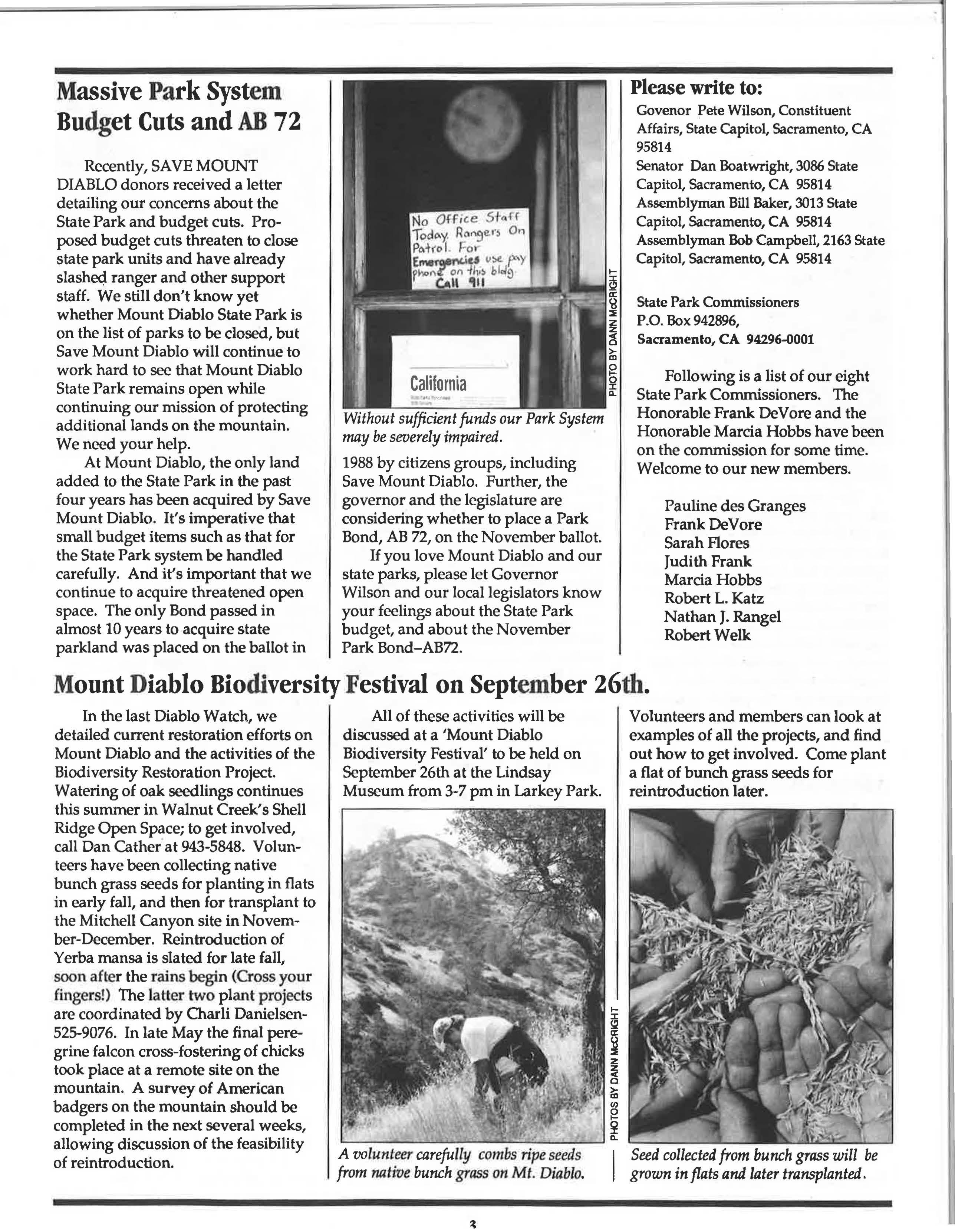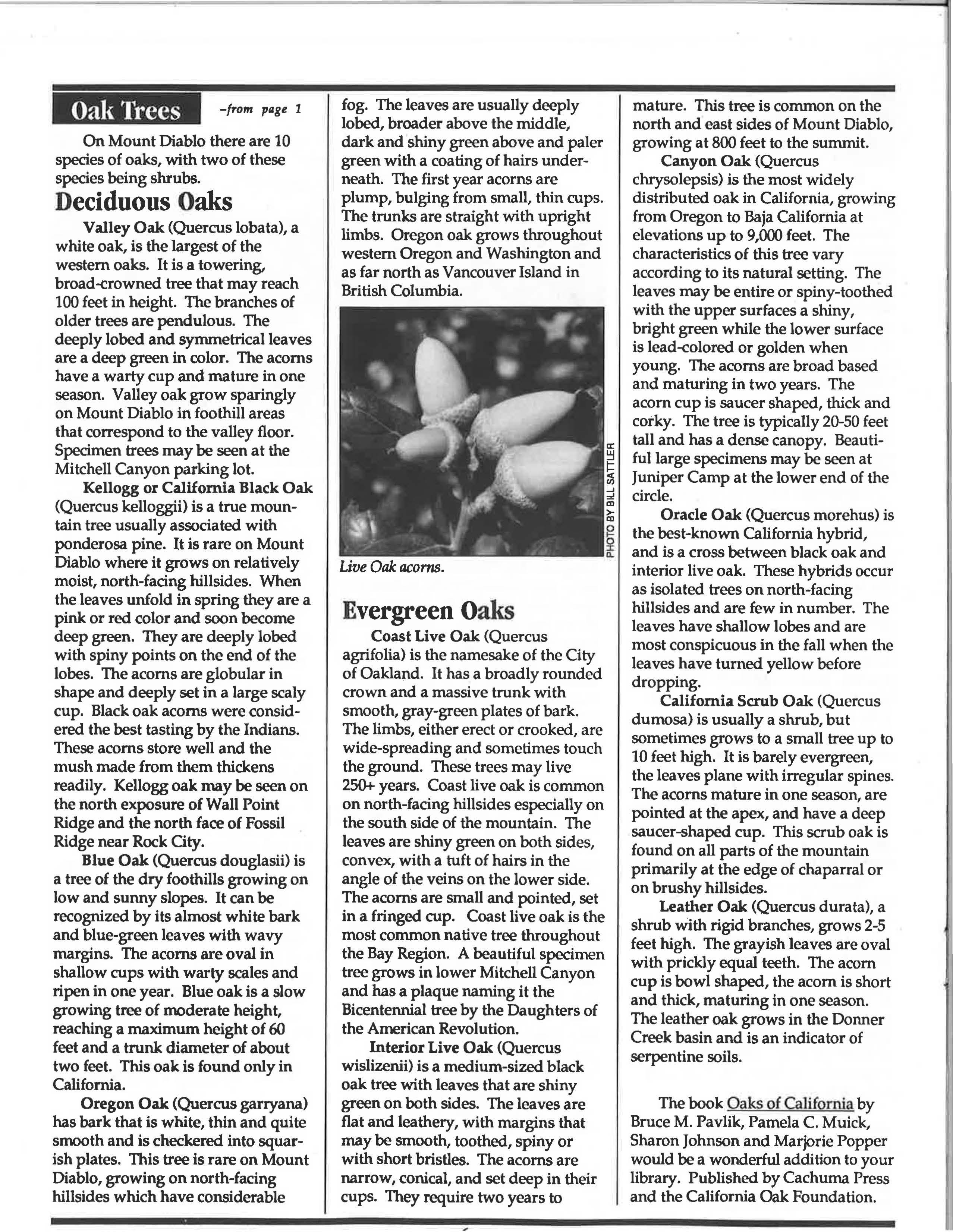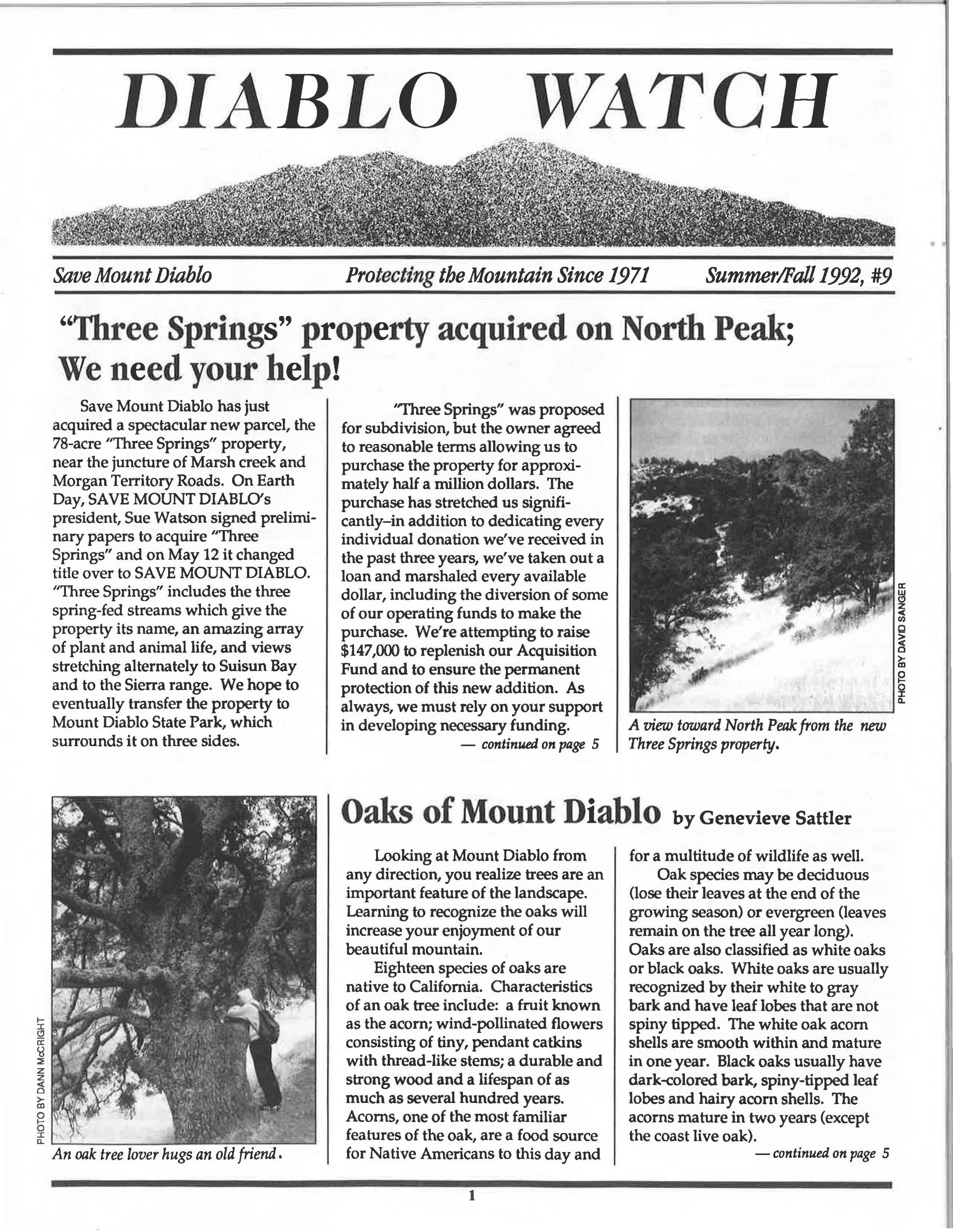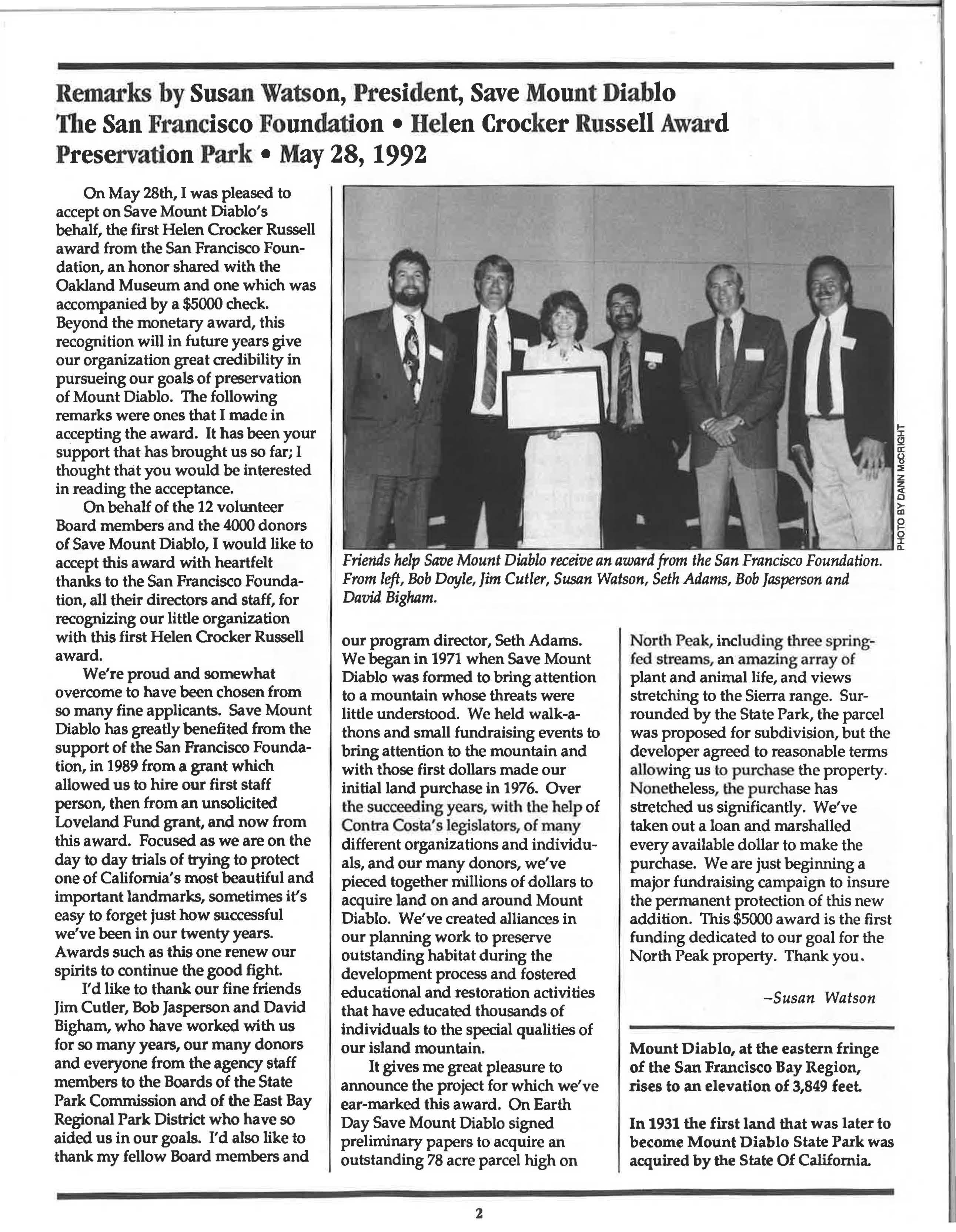Massive Park System Budget Cuts and AB 72
Recently, SAVE MOUNT
DIABLO donors received a letter detailing our concerns about the State Park and budget cuts. Proposed budget cuts threaten to close state park units and have already slashecl ranger and other support staff. We still don't know yet whether Mount Diablo State Park is on the list of parks to be closed, but Save Mount Diablo will continue to work hard to see that Mount Diablo State Park remains open while continuing our mission of protecting additional lands on the mountain. We need your help.
At Mount Diablo, the only land added to the State Park in the past four years has been acquired by Save Mount Diablo. It's imperative that small budget items such as that for the State Park system be handled carefully. And it's important that we continue to acquire threatened open space. The only Bond passed in almost 10 years to acquire state parkland was placed on the ballot in
California
Without sufficient funds our Park System may be severely impaired. 1988 by citizens groups, including Save Mount Diablo. Further, the governor and the legislature are considering whether to place a Park Bond, AB 72, on the November ballot.
If you love Mount Diablo and our state parks, please let Governor Wilson and our local legislators know your feelings about the State Park budget, and about the November Park Bond-AB72.
Please write to:
Govenor Pete Wilson, Constituent Affairs, State Capitol, Sacramento, CA 95814
Senator Dan Boatwright, 3086 State Capitol, Sacramento, CA 95814
Assemblyman Bill Baker, 3013 State Capitol, Sacramento, CA 95814
Assemblyman Bob Campbell, 2163 State Capitol, Sacramento, CA 95814
State Park Commissioners
P.O. Box 942896, Sacramento, CA 94296-0001
Following is a list of our eight State Park Commissioners. The Honorable Frank DeVore and the Honorable Marcia Hobbs have been on the commission for some time. Welcome to our new members.
Pauline des Granges
Frank DeVore
Sarah Flores
Judith Frank
Marcia Hobbs
Robert L. Katz
Nathan J. Rangel
Robert Welk
Mount Diablo Biodiversity Festival on September 26th.
In the last Diablo Watch, we detailed current restoration efforts on Mount Diablo and the activities of the Biodiversity Restoration Project. Watering of oak seedlings continues this summer in Walnut Creek's Shell Ridge Open Space; to get involved, call Dan Cather at 943-5848. Volunteers have been collecting native bunch grass seeds for planting in flats in early fall, and then for transplant to the Mitchell Canyon site in November-December. Reintroduction of Yerba mansa is slated for late fall, soon after the rains begin (Cross your fingers!) The latter two plant proj ects are coordinated by Charli Danielsen525-9076. In late May the final peregrine falcon cross-fostering of chicks took place at a remote site on the mountain. A survey of American badgers on the mountain should be completed in the next several weeks, allowing discussion of the feasibility of reintroduction.

All of these activities will be discussed at a 'Mount Diablo Biodiversity Festival' to be held on September 26th at the Lindsay Museum from 3-7 pm in Larkey Park.
Volunteers and members can look at examples of all the projects, and find out how to get involved. Come plant a flat of bunch grass seeds for reintroduction later.
A volunteer carefully combs ripe seeds from native bunch grass on Mt . Diablo.
Seed collected from bunch grass will be grown in flats and later transplanted.

Shorts ...
Marsh Creek Specific Plan
The City of Clayton is nearing completion of its Marsh Creek Specific Plan and beginning the environmental impact process for the report. If you'd like to receive notices on this important plan, which treats potential development of the area east of Clayton, send a 5 or 6 SelfAddressed Stamped Envelopes to City of Oayton, P.O. Box 280, Clayton, CA 94517, and specify: Marsh Creek Specific Plan. For more infor, call Program Director Seth Adams, at (510) 229-4275.
Musco Ranch
Various readers have called to ask about the progress of acquisition of the 560-acre Musco Ranch, which East Bay Regional Park District approved last August 20th. Musco, ?lso known as the MAM project, is JUSt south of SAVE MOUNT
DIABLO's Morgan Ranch acquisition and will cement a mile wide wildlife corridor in Riggs Canyon from the Stat~ Park to Morgan Territory Regional Park. The project is now in the hands of the courts to determine a fair price.
Athenian School-Black Oak Estates
The Athenian School Project has moved slowly through the planning process, and was approved earlier this _year by the San Ramon Valley Regional Planning Commission. The approval ignores direction from the Board of Supervisors to preserve an upper knoll and replaced several houses which SAVE MOUNT DIABLO has worked to eliminate from the slopes of the adjacent stream canyon. These several houses require a road across the back of the upper knoll. The hearing before the Supervisors has not been scheduled yet but will likely take place in July. '
Please write to the Board of Supervisors, asking them to remove
or re-locate the lots from the knoll and stream canyon and to dedicate these areas to the State Park or as permanent open space.
Write: Board of Supervisors, Con~a Costa County, P.O. Box 911, Martinez, CA 94553.
Board and Committee Openings
Save Mount Diablo holds meetings of the Board of Directors mon~ly, and committee meetings at dates in between. There is no question that meetings can sometimes be long and are often complicated, but once you master the names of properties being considered for acquisition or development, they are extremely rewarding. There are presently volunteer openings on the Fundraising and Publications Committees, and on the Board. Individuals with skills in planning, fundraising or newsletter production are especially needed. If you're interested in attending a meeting or getting involved, please call Program Director Seth Adams at (510) 229-4275.
Contributions
.
To Save Mount Diablo
Are tax-deductible to the full extent provided by law. Checks should be made payable to:
Save Mount Diablo P.O. Box25 Concord, CA 94522
Special Donations
Save Mount Diablo would like to thank Joann Hanna for her do~tion of a four drawer filing cabinet. Our others are jam-packed!
Supenrisor Torlakson Re-elected
On June 2nd, voters in east county re-elected Tom Torlakson to his seat avoiding a November run-off with ' more than 50% of the vote in a field of five candidates. Save Mount Diablo does not endorse candidates, but we were pleased to see that Tom was reelected. He's been a strong supporter over the years and was one of the speaker~ at our 20th Anniversary celebration. Congratulations, Tom!
Hellos & Goodbyes
Fare thee well Felix!
~istrict Director Felix Arteaga is leaving the Mount Diablo District on July 14, 1992. Felix will be working in Sacramento for the State Department ?f Fish and Game. His new position 1s Assistant Division Chief in the ~atural Heritage Divsion. We regret his move - our loss is their gain.
Kansas-bound Bates
Ranger Cindy Bates is leaving Mount Diablo State Park on August 1, 1992. She is moving to Kansas where her family lives and is applying for conservation-oriented work in this Great Plains state. Cindy, we will miss your happy, smiling face.
• •
Three Springs -from ptage 1
Only then can we purchase another property.
The "Three Springs" parcel is adjacent to SAVE MOUNT DIABLO's first acquisition (the Morgan Territory Investment Property in 1976, at the corner of and adjacent to Marsh Creek and Morgan Territory Roads).
"Three Springs" is one of a group of several adjacent in holdings. It ranges from 920 feet to 1800 feet above sea level, high up the northeast side of North Peak and consists of fairly developable lands as well as rugged and rock-strewn slopes and outcroppings. The lower part of the property is crossed by a historic stagecoach route that once connected Martinez with Stockton.
Its springs feed a beautiful stream canyon with large oaks, maples and sycamores and entwined with wild grape and honeysuckle, running through oak-bay woodlands and flanked by rocky outcroppings; the property's acquisition will ensure the preservation of the entire length of the stream. "Three Springs" supports an array of rare plant and animal species. Botanically the parcel is extremely important, and very lush with well-preserved riparian areas around and below each spring.
We must rely on your support In developing necessary funding. Only then can we purchase another property.
When surveying the property, SAVE MOUNT DIABLO's Land Committee saw large numbers of the Mount Diablo Globe Lily, which is limited to Mount Diablo, large numbers of Mariposa Lilies, in addition to larkspur, brodiaea, indian warriors, gum plant, dudleya, three species of ferns including slopes of maidenhair ferns, cardinal flowers, dogwoods, wild currant, and many other wildflowers.
Based on an initial wildlife survey, "Three Springs" is likely to include Cooper's and Sharp-shinned hawks, golden eagles, peregrine and prairie falcons, the Alameda whipsnake, and potentially the

previously thought extinct Berkeley Kangaroo Rat. We saw deer and many bird species. It also includes spectacular views to Black Diamond Mines, and across the Delta to the Sierra Nevada range. On a recent visit, sailboats could be seen on Suisun Bay from the property. An existing house and several barns will remain on a 5-acre private parcel divided from the open space portions of the parcel.
Robert Doyle, SAVE MOUNT DIABLO's administrative vicepresident who negotiated the deal explained, "Save Mount Diablo has been interested in the 'Three Springs' parcel since our first purchase because of its outstanding natural values. The Department of Parks and Recreation expressed formal interest in 1988. Purchase was not possible until late last year when Bob and Dana Nunn (of Ronald Nunn Farms) negotiated an option at a reasonable price, through personal contacts with the owner. Their intent was to live on part of the property in an existing house while subdividing the rest of the 82 acres. Save Mount Diablo convinced the Nunns to give us a chance to come up with the money to acquire the property. The deal we agreed to is ideal-we don't have to buy a house we don't need and got a good price as a result. Now we have
to hold up our end and raise the funds." The agreement includes a restriction on development of the 5 acres that remains in private hands.
On May 28th Save Mount Diablo kicked off fundraising for the parcel when we received the first Helen Crocker Russell award (see 'President's message') from the San Francisco Foundation, 'for improving the quality of life in Alameda and Contra Costa counties'. The award included a $5000 grant. "We're grateful for the San Francisco Foundation's recognition of the importance of our work with this award, and we are dedicating the grant to the acquisition campaign for the 'Three Springs' parcel", said Watson. Save Mount Diablo members can see "Three Springs" during a series of hikes later this summer and fall (see 'Hikes and Events'). For more information write to SAVE MOUNT DIABLO, P. 0. Box 25, Concord, CA 94522 or call us (510) 229-4275.
SAVE MOUNT DIABLO
Save Mount Diablo 's recent acquisition - the Three Springs property lies below the ridge on the left skyline of the mountain. A white tower marks the site of the uppermost of the three springs.
s
AND STILL COUNTING!
Oal, Trees

-from page 1
On Mount Diablo there are 10 species of oaks, with two of these species being shrubs.
Deciduous Oaks
Valley Oak (Quercus lobata), a white oak, is the largest of the western oaks. It is a towering, broad-crowned tree that may reach 100 feet in height. The branches of older trees are pendulous. The deeply lobed and symmetrical leaves are a deep green in color. The acorns have a warty cup and mature in one season. Valley oak grow sparingly on Mount Diablo in foothill areas that correspond to the valley floor. Specimen trees may be seen at the Mitchell Canyon parking lot.
Kellogg or California Black Oak (Quercus kelloggii) is a true mountain tree usually associated with ponderosa pine. It is rare on Mount Diablo where it grows on relatively moist, north-facing hillsides. When the leaves unfold in spring they are a pink or red color and soon become deep green. They are deeply lobed with spiny points on the end of the lobes The acorns are globular in shape and deeply set in a large scaly cup. Black oak acorns were considered the best tasting by the Indians. These acorns store well and the mush made from them thickens readily. Kellogg oak may be seen on the north exposure of Wall Point Ridge and the north face of Fossil Ridge near Rock Oty.
Blue Oak (Quercus douglasii) is a tree of the dry foothills growing on low and sunny slopes. It can be recognized by its almost white bark and blue-green leaves with wavy margins. The acorns are oval in shallow cups with warty scales and ripen in one year. Blue oak is a slow growing tree of moderate height, reaching a maximum height of 60 feet and a trunk diameter of about two feet. This oak is found only in California.
Oregon Oak (Quercus garryana) has bark that is white, thin and quite smooth and is checkered into squarish plates. This tree is rare on Mount Diablo, growing on north-facing hillsides which have considerable
fog. The leaves are usually deeply lobed, broader above the middle, dark and shiny green above and paler green with a coating of hairs underneath. The first year acorns are plump, bulging from small, thin cups. The trunks are straight with upright limbs. Oregon oak grows throughout western Oregon and Washington and as far north as Vancouver Island in British Columbia.
mature. This tree is common on the north and east sides of Mount Diablo, growing at 800 feet to the summit.
Canyon Oak (Quercus chrysolepsis) is the most widely distributed oak in California, growing from Oregon to Baja California at elevations up to 9,000 feet. The characteristics of this tree vary according to its natural setting. The leaves may be entire or spiny-toothed with the upper surfaces a shiny, bright green while the lower surface is lead-colored or golden when young. The acorns are broad based and maturing in two years. The acorn cup is saucer shaped, thick and cotky. The tree is typically 20-50 feet tall and has a dense canopy. Beautiful large specimens may be seen at Juniper Camp at the lower end of the circle.
Evergreen Oaks
Coast Live Oak (Quercus agrifolia) is the namesake of the City of Oakland. It has a broadly rounded crown and a massive trunk with smooth, gray-green plates of bark. The limbs, either erect or crooked, are wide-spreading and sometimes touch the ground. These trees may live 250+-years. Coast live oak is common on north-facing hillsides especially on the south side of the mountain. The leaves are shiny green on both sides, convex, with a tuft of hairs in the angle of the veins on the lower side. The acorns are small and pointed, set in a fringed cup. Coast live oak is the most common native tree throughout the Bay Region. A beautiful specimen tree grows in lower Mitchell Canyon and has a plaque naming it the Bicentennial tree by the Daughters of the American Revolution.
Interior Live Oak (Quercus wislizenii) is a medium-sized black oak tree with leaves that are shiny green on both sides. The leaves are flat and leathery, with margins that may be smooth, toothed, spiny or with short bristles. The acorns are narrow, conical, and set deep in their cups. They require two years to
Oracle Oak (Quercus morehus) is the best-known California hybrid, and is a cross between black oak and interior live oak. These hybrids occur as isolated trees on north-facing hillsides and are few in number. The leaves have shallow lobes and are most conspicuous in the fall when the leaves have turned yellow before dropping.
California Scrub Oak (Quercus dumosa) is usually a shrub, but sometimes grows to a small tree up to 10 feet high. It is barely evergreen, the leaves plane with irregular spines. The acorns mature in one season, are pointed at the apex, and have a deep saucer-shaped cup. This scrub oak is found on all parts of the mountain primarily at the edge of chaparral or on brushy hillsides.
Leather Oak (Quercus durata), a shrub with rigid branches, grows 2-5 feet high. The grayish leaves are oval with prickly equal teeth. The acorn cup is bowl shaped, the acorn is short and thick, maturing in one season. The leather oak grows in the Donner Creek basin and is an indicator of serpentine soils.
The book Oaks of California by Bruce M. Pavlik, Pamela C. Muick, Sharon Johnson and Marjorie Popper would be a wonderful addition to your library. Published by Cachuma Press and the California Oak Foundation.
Live Oak acorns.
Hikes and Events
Sat July 25, 9:00 am, Leader: Don de Fremery, 837-5646; "Three Springs" Acquisition; This is the first opportunity to hike on SAVE MOUNT DIABLO's newest acquisition (see front page article). There is significant elevation gain, but the distances are short, and much of the trail shaded. 3-4 hours. Spectacular views and plant life. Meet at the gate on the south side of Marsh Creek Rd., 5.0 miles east of Y gnacio Valley Blvd. down Clayton then Marsh Creek Rd.
Sat, Aug 8, 9:00 am, Leader: Susan Watson, 229-4275; "Three Springs" Acquisition; See July 25th for details. Led by SAVE MOUNT DIABLO president Sue Watson, this hike will be especially good in identifying bird and plant species.
Sat, Aug. 22, 3:00 pm, Leader: Diane Lake, 799-1769; "Three Springs" Acquisition; a joint SMD and CNPS hike; See July 25th for details. Diane Lake is the Unusual and Rare Plants coordinator for the California Native Plants Society-East Bay Chapter, and will be able to identify most of the plants on this hike.
Sat Aug 29, 9:00 am Leader: David Sanger, 526-4465; Wall Point Loop, Meet at Curry Point for this 9 mile hike. We will climb up the summit trail to Barbeque Terrace and then descend into Pine Canyon. After a lunch stop at Pine Pond we will climb steeply up Pine Ridge to Wall Point with a clear view of Rocky Ridge to the west and the Mount . Diablo summit to the east. Approximately 2000 feet of elevation gain. Bring good shoes and lots of water.
Sat, September 19, 9:00 am, Leader: David Sanger, 526-4465; "Three Springs" Acquisition, See July 25th for details.

Sat, Sept. 26, 3-7:00 pm Mt. Diablo Biodiversity Festival, Info: 229-4275; Picture the mountain in its historic condition. Join members of the Mount Diablo Biodiversity Restoration Project at the Lindsay Museum in Walnut Creek's Larkey Park (1901 First Ave.) for a fun event emphasizing the restoration projects being conducted on Mount Diablo. Come plant a flat of bunch grass seeds for reintroduction later, see peregrine falcons and rare plants. Volunteers and members can look at examples of all the projects, and find out how to get involved Children welcome.
Sun., Oct. 4, 9:00 am, Leader: Don de Fremery, 837-5646; Mt. Olympia and the "Three Springs" Acquisition, This hike will begin low on the mountain and rise up beautiful Mt. Olympia. A longer hike, call leader for details, and see July 25th for directions. Heavy rain cancels.
Sat, Oct. 24, 9:00 am, Leader: Bob Doyle, 229-4275; "Three Springs" Acquisition; Join SAVE MOUNT DIABLO Vice-President Bob Doyle on the last hike of the series on SAVE MOUNT DIABLO's newest acquisition. Doyle, who led negotiations for the new purchase is an expert on the area's natural history. See July 25th for details. Heavy rain cancels.
Save Mount Diablo BOARD OF DIRECTORS:
Susan Watson, President
Mary L. Bowerman, Vice-President; Robert E. Doyle, Vice-President
Elizabeth Zilen, Vice-President
Judson Myga~ Treasurer
Genevieve Sattler, Secretary
William Sattler, Assistant Secretary
Directors
EricHinzel
Dann McCright
Patrice Moran
Chris Valle-Riestra
Bob Walker
Program director
Seth Adams
THANK YOU
w, sspsc/ally apprsciats th, generous contributions of our many support,rs, you maks our work protscllng Mount Diab/a possibls.
Diab/a Watch is published by SAVE MOUNT DIABLO, a nonprofit organization dedicate~ to preserving land on Mount D1ablo and educating the public to the mountain's natural values.
Editor/Production Dann McCright Coordinator
Contributors this issue
Seth Adams
Mimi Foord
Sue Keeley
Dann McCright
David Sanger
Bill Sattler
Genevieve Sattler
Susan Watson
Our speclal 1hanks to J Morgan Graphics of
• I 0 o•
Hiker and spring wildflowers high on the East Trail of Mount Diablo,
er:
i Cl) Q lii a..
for printing this Issue of IHablo W11tcb 0 IHablo W11tcb Is printed on recycled paper that can be recycled again
Concord
The familiar twin peaks of Mount Diablo, with dense commercial development near Pleasant Hill BART station in the foreground. This view of Mount Diablo rising above Diablo Valley is from Dinosaur Hill Vista in Pleasant Hill.

Save Mount Diablo is a non-profit 501(c)(3) organization which has been preserving land on Mount Diablo and educating the public to the mountain's natural values since 1971. Preserved lands have more than tripled in that period. Save Mount Diablo continues to raise funds to preserve the remainder of the mountain.
save mounT DIABLO P.O. Box 25 / Concord, Calll~mla
Return Postage Guaranteed ..
94522
NON-PROFIT ORG U.S. POSTAGE PAID Concord, CA Permit No. 525








